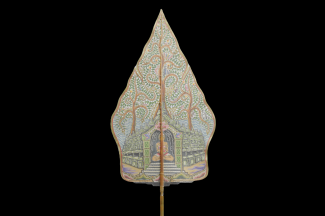Surakarta, Central Java, around 1946
Wayang kulit (leather puppets) is an ancient form of storytelling that originated in Java. For ten centuries, wayang flourished at the royal courts of Java and Bali before becoming a popular medium for storytelling for the common people, often telling stories from the Ramayana.
The Wayang Revolusi is a contemporary version, adapted to support the struggle for Indonesia’s independence. In a time before television and limited radio access, Wayang Revolusi played an essential role in raising awareness of unity and solidarity among Indonesians during the resistance against the Dutch.
The wayang was performed at small community gatherings across Java, as the dalang (puppet master) shared the story of Indonesia’s struggle for independence. The collection is very rare, with only a few of the wayang sets remaining. Importantly, the Wayang Revolusi includes several figures of important women involved in the struggle for independence.
The collection also highlights the relationship between Indonesia and Australia during this period. Seven weeks after the 17 August proclamation, Australia sent a diplomatic mission to meet with President Sukarno to lay the groundwork for recognizing the Indonesian Republic. In support of Indonesia’s declaration of independence, Australian dock workers famously refused to service Dutch ships transiting through Australia in an event known as the “Black Armada.”
The body of the puppet is made from buffalo leather, while the joints and sticks are made from buffalo horn and wood/bamboo. The size varies, with an average length of 50 cm and a width of 19 cm.
The Wayang Revolusi collection at the Wayang Museum was purchased by the Wereldmuseum in 1960. The Wereldmuseum is an ethnographic museum that holds collections from various cultures in Asia, including Indonesia. This Wayang Revolusi collection is a loan from the Wereldmuseum for Museum Wayang Jakarta in a long-term arrangement made to celebrate the 60th anniversary of Indonesia's independence. The collection was handed over to the Wayang Museum in 2005.
Inventory Number: MW/I/J-2
Materials: Buffalo leather, buffalo horn, bamboo/wood
Dimensions: Height 50 cm, Width 19 cm
Educator, UP. Museum Wayang, Dwi Nur Ratnasari, shares the significance of Wayang Revolusi.
Revo and Lusi: Wayang Revolusi at the Wayang Museum (Kota Tua, Jakarta).
This video was produced as part of the Tetangga Exhibition 2024 by Fajrina Safira.
Curators
Dwi Nur | Wayang Museum
Halim Margo Pratama | Benyamin Sueb Museum
Fajrina Safira | Cultural Heritage Conservation Center
Ahmad Ali | Museum of Fine Arts and Ceramics




